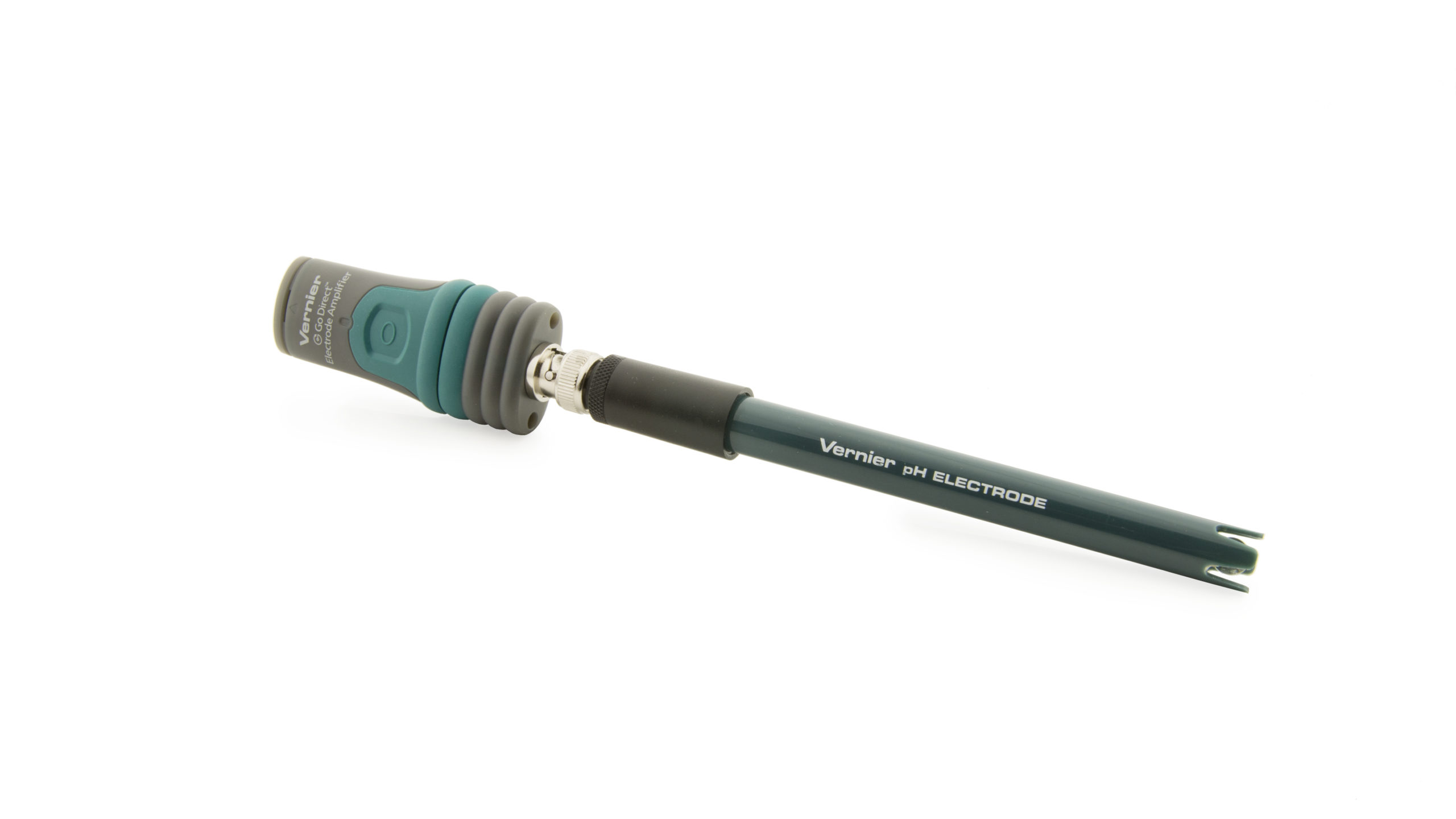Go Direct® pH Sensor
GDX-PH—Single Sensor
GDX-PH-TP—8 Sensors + Charging Station

Troubleshooting
General: Press the power button on the sensor to turn it on. Connect your sensor as described in the Getting Started instructions for your device. (The green LED will flash to indicate the sensor is connected.)
- Primary Test: It should read approximately 4 in its storage solution.
- Secondary Test: Take readings in fresh buffers, NOT distilled water!
⚬ The pH reading should be within 0.2 pH units of the pH buffer. For example, if using a pH 4.0 buffer, your reading should be between 3.8 and 4.2.
⚬ If no buffers are available, try it in vinegar (~ pH 2.5-3.5) and ammonia (~ pH 10.5-11.5).
⚬ If readings do not change when the sensor is placed in different solutions, the sensor is possibly defective or damaged. - Tertiary Test: Confirm that the BNC connection is secure.
Additional Troubleshooting
- Blog post: Answers to your top five pH questions
- Blog post: The right pH for your lab
- Which pH Sensor Should I Buy?
OPERATION
- Properly Separating the Go Direct pH Probe at the BNC Connection
- The glass bulb of my pH Sensor is broken. Can it be repaired?
- The pH electrode I have been using no longer seems to work or is slow to respond. Is there anything I can do to fix it?
- My pH probe does not give an accurate reading. What should I do?
- Why doesn't my pH Sensor read pH 7 in distilled or deionized water?
- What type of liquids cause problems for the pH Sensor?
- Go Direct sensor does not connect to LabQuest 2 via Bluetooth.
- Troubleshooting Bluetooth Connections with Go Direct Sensors
- What can I do if a Go Direct sensor's Bluetooth LED flashes red and green when I try to connect to it and the connection fails?
- Will my device work with Go Direct Sensors via Bluetooth?
- How do I know if my LabQuest will work with Go Direct Sensors and Go Wireless devices?
MAINTENANCE AND STORAGE
- Where do I get pH or ORP Storage Solution? (Buffer Storage Solution)
- What do I do about mold growth in my bottle of pH electrode storage solution?
- How can I keep my pH or ORP storage solution from spilling when the sensor is in use?
- My pH sensors were stored dry. Will they still work?
- What is the best way to clean the glass bulb of the pH electrode?
- Do any of your sensors require special storage?
- I bought your pH buffer capsules. Can I make storage solution for my pH Sensors with this kit?
- How do I dispose of my pH sensor?
- How do I replace the battery in a Go Direct Wand-Style Sensor?
Specifications
PH ELECTRODE
- Type: Sealed, gel-filled, polycarbonate body, Ag/AgCl reference, single junction
- Accuracy with new electrode: ±0.2 pH units
- Temperature range: 5 to 80 °C (readings not compensated)
⚬ Isopotential pH: pH 7 (point at which temperature has no effect) - Storage solution: pH-4/KCl solution (10 g KCl in 100 mL buffer pH-4 solution)
- Dimensions
⚬ Shaft diameter: 12 mm OD
⚬ Shaft length: 15.5 cm
ELECTRODE AMPLIFIER
- pH range: 0–14
- Resolution: 0.01 pH units
- Dimensions (amplifier only): 8.5 cm × 3 cm × 1.75 cm
- Connections:
⚬ Wireless: Bluetooth® v4.2 (wireless range 30 m unobstructed)
⚬ Wired: USB 2.0 full speed - Battery: 300 mA Li-Poly
⚬ Battery Life (single, full charge): ~24 hours continuous data collection
⚬ Battery Life (lifetime): 2 – 5 years (typical)
Calibration
Calibrate? Usually no. However, for the most accurate measurements with this sensor, we recommend calibration. It is a simple process that only takes a few minutes. Calibrations are stored directly onto the sensor. For more information on calibration, see How do I calibrate my sensor?
- Why does my pH sensor experience drift or calibration issues?
- Where do I get pH buffer solutions?
- How do I change the displayed measurement channel on my Go Direct Electrode Amplifier or ISE Amplifier?
Battery Troubleshooting
- If the sensor can be turned on when connected by USB but not when disconnected from USB, the battery either needs charging or has reached its end of life and can no longer hold a charge.
⚬ First, try charging the sensor for several hours. - If the sensor still won’t turn on when disconnected from USB, try swapping the battery with a working sensor to see if the problem follows the battery or stays with the sensor.
⚬ If the problem stays with the sensor, the battery is probably not the issue.
⚬ If the problem follows the battery, the battery has likely reached its end of life. - If you intend to use this sensor wirelessly, its battery will need replacing.
Go Direct® 300 mAh Replacement Battery (GDX-BAT-300 ) - See How do I replace the battery in a Go Direct Wand-Style Sensor? for more information (including a video).
Rechargeable batteries are covered by a one-year warranty.
Batteries should last two to five years in typical use.
Related Products
- pH Buffer Capsule Kit (
PH-BUFCAP ) - Micro USB to USB-C Cable (
CB-USB-C-MICRO ) - Go Direct® Charge Station (
GDX-CRG ) - Electrode Support (
ESUP ) - Go Direct® Sensor Clamp (
GDX-CLAMP ) - Stir Station (
STIR ) - Go Direct® Drop Counter (
GDX-DC ) - pH Sensor (
PH-BTA )
Replacement Parts
- Go Direct® 300 mAh Replacement Battery (
GDX-BAT-300 ) - Micro USB Cable (
CB-USB-MICRO ) - Go Direct® Electrode Amplifier (
GDX-EA ) - Go Direct® pH BNC Electrode (
GDX-PH-BNC ) - Storage Solution Bottles (5) (
BTL ) - pH Storage Solution (
PH-SS )
